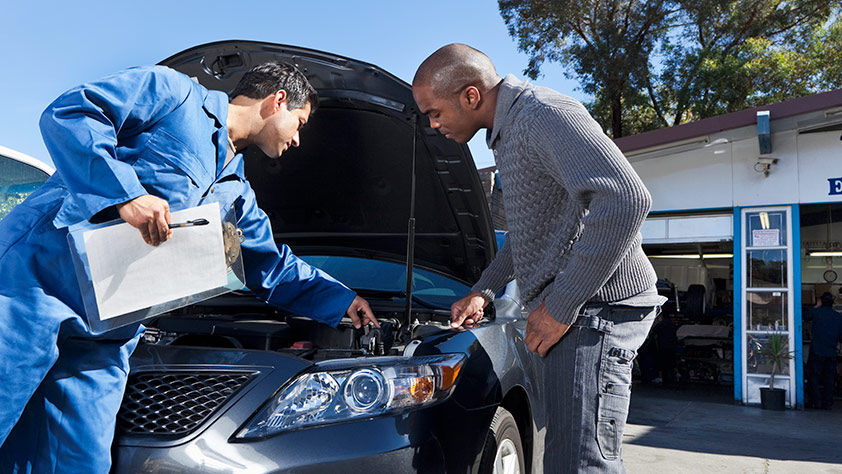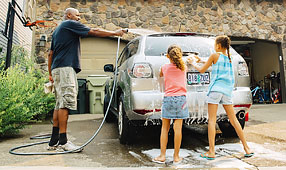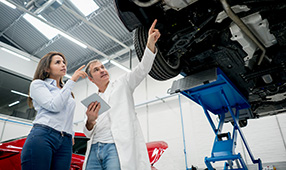Our cars are one of the biggest investments we make, and we rely on them to get us to school, to soccer practice, to the grocery store and everywhere in between. Regular maintenance will ensure that those expensive machines will function at peak performance and last a long, long time.
At a minimum, you should follow the recommended maintenance schedule, which you can find in your owner’s manual (you’ve read it, right?). That list covers everything from oil changes to timing belt replacement. Even if you do nothing else for your vehicle, make sure you have all of these services done on schedule.
Some manufacturers adjust the frequency of service depending on the type of driving you do. Don’t be surprised if your short daily commute qualifies as “severe” use. Frequent short trips mean more cold starts (when most engine wear occurs), as well as more acceleration and braking, which add stress to many components in your vehicle. Having all of these services done on schedule will prolong the life of your car and also may help if you need to make a warranty claim.
If your car is under warranty, get all recommended interval services done at the dealer so they’ll have a record of the work performed. This will come in handy if you need warranty work by reducing the chance of your claim being disputed.
Your vehicle is a multi-ton hunk of metal that requires various fluids to keep all of the parts operating correctly. These three tasks are critical, especially if you plan to keep your car for many years:
Change the oil regularly. The quality of motor oil has improved tremendously since the old “every 3,000 miles” recommendation, and some newer cars (especially those that use synthetic oil) can go as long as once a year or every 15,000 miles before needing an oil change.
The general consensus among mechanics we’ve spoken to is to change your oil twice a year or once every 5,000 miles. Some cars, however, may require a change more often than that. Frequent oil changes are cheap insurance, and we’ve never heard anyone say they had problems from changing the oil more often than recommended.
If you do your own oil changes, dispose of the used oil at a recycling facility. The used oil from one oil change can contaminate 1 million gallons of fresh water—a years’ supply for 50 people.
Test the brake fluid periodically. Hydraulic brake fluid is hygroscopic, meaning it absorbs moisture from the atmosphere. Moisture in the brake lines can corrode the system and affect the performance of your brakes. Have the fluid tested every two years, and change it if needed.
Monitor your “lifetime” fluids. Some manufacturers claim that certain fluids (such as coolant and automatic transmission fluid) are “lifetime,” meaning they’re good for the life of the car and don’t require changing. Although changing them may not be necessary, the performance of these fluids often degrades over time as they pick up contaminants. If your car’s a keeper, consider changing these fluids when you hit the 50,000-mile mark.
Here are four more smart tips to help ensure trouble-free transportation for years to come:
1. Drive gently at first. Accelerate lightly for the first few miles until your car is warmed up. Modern engines rely on extremely tight tolerances between parts and are made of advanced alloys that perform best within a narrow temperature range. Rubber seals and gaskets also depend on the correct temperature to seal properly. By letting the engine and transmission warm up before pushing them hard, you’ll add years of life to your ride.
2. Avoid short trips, especially when it’s cold. Short trips, particularly during winter, can lead to condensation developing in your exhaust system (the steam coming out of your tailpipe) and in your engine oil. This condensed water contributes to rust in your exhaust system and degrades the performance of your oil, both of which can lead to expensive repairs. If you do have to make short trips of about 10 miles or less, make sure your car warms up completely, and try to take the long way home to let the condensation evaporate.
3. Wash and wax your car regularly. Dirt, oil, road salt and other debris can affect both the performance and appearance of your car. Wash your car once a month, either yourself or at a commercial car wash. Giving the vehicle a coat of paste wax twice a year will help protect the finish from the elements and make it easier to clean next time around.
Don’t wait to wash off any bird droppings or tree sap, though. Clean it off as soon as you see it, preferably the same day. Bird droppings can etch the clearcoat finish on your car and leave a mark that only a professional can remove. Tree sap usually won’t etch the finish, but the longer it sets, the more difficult it will be to remove.
4. Find a good independent mechanic. The time to get to know a good mechanic is before you’re stuck on the side of the road. And even if your car is still under warranty, sometimes it’s nice to get a second opinion on repairs that your dealer recommends.
Once your car is out of warranty, there’s no reason to have routine maintenance done at a dealership. Check enthusiast message boards for recommendations of good mechanics in your area. The corner service station may not have all the equipment needed to do major service on a modern car, but an independent mechanic who specializes in your make should have everything necessary.












